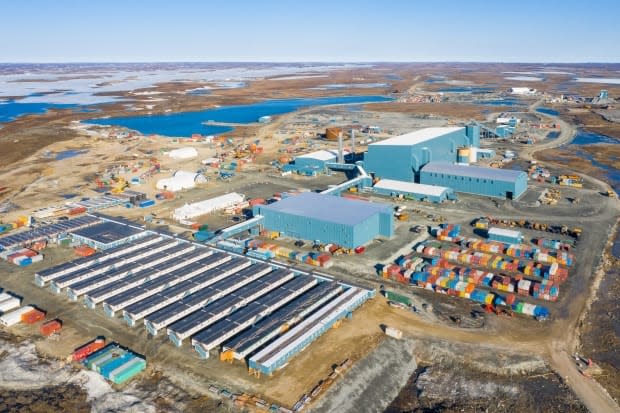Nunavut mine's study on caribou roundly rejected

A scientific analysis commissioned by Agnico Eagle that found the mining road near Meliadine Mine in the Kivalliq region is having virtually no impact on migrating caribou is being roundly criticized by Nunavut agencies.
"It became pretty clear that they're not analyzing data correctly," Clayton Tartaq, research coordinator with the Kivalliq Wildlife Board, told CBC News.
Community organizations and members near the mine participated in a roundtable discussion held by the Nunavut Impact Review Board last month.
The focus of the meeting was Agnico's proposal to bury pipelines in order to dramatically increase the amount of saline water discharged from the mine into Melvin Bay.
"Community members noticed that there were changes not only in the migration route of caribou, but the volume of the migration in certain areas," because of the mining road, Tartaq said.
Mitch Campbell, a wildlife biologist with the Nunavut government living in Arviat, also said community members raised concerns about changes in caribou behaviour.
"Pretty much every stakeholder there had significant concerns and believes that there's technical flaws with that work that was done, and it needs to be reassessed with an understanding of those flaws," Campbell told CBC.
The Kivalliq Inuit Association (KIA) commissioned a response to the analysis, which found "the conclusions premature and based on partial analysis, which lacks insight into caribou behaviour."
The KIA also said it was "disappointed in the late document submission and the lack of time to discuss the memo."
98 per cent of collared caribou crossed the road: Agnico
When asked for a copy of the report, Agnico spokesperson Carl Charest told CBC in an email the report was still being finalized and would be provided when available.
CBC did obtain a copy of the "Technical Memorandum" provided by Agnico at the roundtable.
According to that document, 163 caribou within 1.5 kilometers of the mining road or other infrastructure were collared between 2014 and 2019.
Out of those, 132 crossed the mining road, or 81 per cent.
But Agnico's report argues that 22 of the collared caribou didn't come close enough to the road to be impacted by the road, and an additional six caribou crossed other mining infrastructure.
That means 132 out of 135 caribou, or 98 per cent, crossed the road, according to Agnico's analysis.
Analysis 'unrealistic' and 'narrow': Kivalliq Inuit Association
But the KIA highlighted a number of areas of concern in its response letter.
First, the data only looked at caribou that came within 1.5 kilometres of the road, which the KIA said is "unrealstic."
Similar studies around the Meadowbank mining road "observed movement zones of influence of 16-17 kilometres," the KIA said.

And the study's definition of those caribou who deflected away from the road was "narrow" and "odd," the KIA said.
That's because Agnico's study only considered caribou to have turned away from the road if they did so at a 90 degree angle.
That means, for instance, caribou who ran parallel to the road, or who took a less direct route to avoid it, were not counted among the caribou whose movement was impacted by the road.
The KIA concluded that a "more rigorous approach to defining deflection" and "more reporting and analysis are needed."
New Terrestrial Advisory Group forming
In response to previous concerns raised by the Nunavut government and Inuit organizations about its caribou monitoring, Agnico has committed to creating a Terrestrial Advisory Group.
The group is comprised of territorial and federal organizations, as well as Indigenous groups who rely on harvesting the herd.

"That group really comes together and looks at the best practices and how we're going to integrate traditional knowledge in our monitoring practices," Frédéric Mercier-Langevin, Meliadine's general manager told CBC News.
Agnico has drafted a set of rules to govern the working group, which it has sent to other stakeholders for review, Mercier-Langevin said.
The final hearing on Agnico's pipelines proposal is expected to be scheduled in the next two months, according to the Nunavut Impact Review Board's hearing process.
Mercier-Langevin said Agnico remains committed to adjusting to community feedback and concerns.
"The whole idea for this [pipeline] project is to basically stop trucking water, and instead install a waterline that would be partially buried, for the most part, and wouldn't disturb any kind of caribou migration," Mercier-Langevin said.

